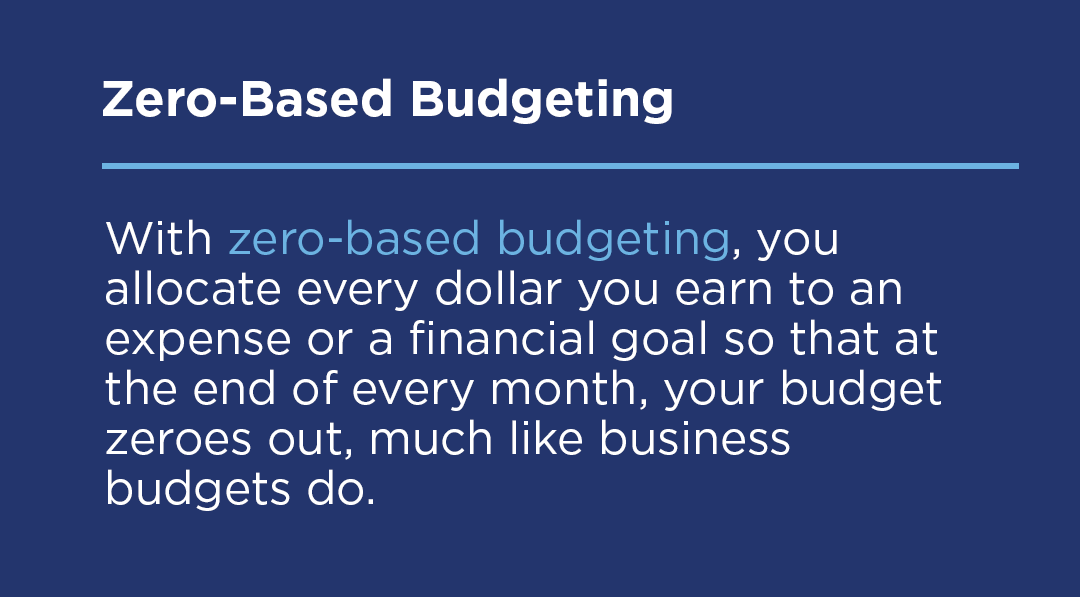Financial experts highly recommend creating and sticking to a budget as one of the best ways to ease the sting of inflation, navigate through a recession and/or survive a layoff. If you’ve been looking for budgeting and personal finance hacks, you may have come across the (interchangeable) terms “zero-based budget (ZBB)” and “zero-sum budget” and wondered what they mean. We define the terms below, explain how they work, and help you determine if a zero-based budget is right for you!
How does a zero-based budget work?
With zero-based budgeting, you allocate every dollar you earn to an expense or a financial goal so that at the end of every month your budget zeroes out, much like business budgets do. To be clear, this doesn’t mean you spend every dollar with no thought of the future. On the contrary, zero-based budgeting identifies your specific financial goals as budget categories, which are assigned a portion of your income just like your expenses.
Financial goals included in a zero-based budget can be short- or long-term ones and as specific as you want them to be. Here are some examples:
- Establishing an emergency fund with six months’ worth of expenses
- Setting aside $800 to replace four balding tires within three months
- Putting aside money each month for birthday and holiday gifts
- Building up enough savings to move out on your own
- Paying off a student loan faster or shrinking credit card debt
- Growing a down payment to buy a new home
- Creating a fund to start a small business
- Saving for retirement
Additionally, your goals may change over time. For example, once you accumulate the $800 needed to get new tires, you can remove that category from your budget. When you do, you’ll need to reallocate that money to another category so that your budget still zeroes out at the end of each month.

How do you create a zero-based budget?
You start creating a zero-based budget the same way you do any budget, by gathering the following information:
- Your current monthly income: Make sure to include money earned from all sources, including side hustles.
- Your average monthly expenses: Look at your checking and credit card statements for the last few quarters to determine how much money you’re spending on average each month for essential spending categories (e.g., your mortgage payment, utilities and groceries) and non-essential ones (e.g., entertainment, clothing and subscriptions).
Next, create a list of your financial goals, including the amount needed to achieve each one within your desired timeframe. For example, let’s say you have $15,000 saved for a mortgage down payment, but you want to grow it to $30,000 within two years to afford the type of house you want. You’ll need to set aside $625 per month in a down payment category to make that happen.
Now, total up your monthly expenses along with the monthly amounts for your financial goals. Then subtract that sum from your monthly income. The result will be one of the following:
- Your budget equals zero: Good for you, you’ve successfully created a zero-based budget! Even so, it can’t hurt to take a final look at your categories to determine if you want to make any adjustments. This could be reducing the amount allocated to entertainment to increase the amount going toward your down payment so you can achieve that goal even sooner.
- Your budget falls below zero: Uh oh, you need to reduce allocations to one or more of your spending categories to create your zero-based budget. You can do this by cutting the amount you’ve budgeted for non-essentials or for your financial goals. In this case, you might consider stretching out your down payment timeline beyond two years.
- Your budget exceeds zero: You’re in great shape, but to make it a true zero-based budget, you need to allocate the extra money to one or more spending categories. For example, you could set more aside each month for your down payment.
What else should you consider before adopting a zero-sum budget?
Before you adopt a zero-based or zero-sum budget, it’s important to understand that the following things help it work as intended, so you’ll need to honestly answer a few related questions:
- Weekly or more frequent category tracking: Do you have the time or inclination to monitor you’re spending this often?
- A time-saving tracking tool: Are you comfortable using a budgeting app, such as GoodBudget, Mint or PocketGuard, that makes budget tracking easier than if you use pen and paper or spreadsheets?
- Careful credit card spending: Are you disciplined enough to limit your credit card spending to only what is allocated in your budget?
One last tip: If you decide a zero-based budget is right for you, consider opening a savings account for your financial goals (or one for each goal) and scheduling automatic deposits into it. You can set up direct deposits straight into your accounts, or you can schedule automated recurring transfers. This will keep you from using money you intended for such goals on other things.
Editor’s note: Quorum is not affiliated with any of the companies mentioned in this article and derives no benefit from these businesses for placement in this article.






Comments Section
Please note: Comments are not monitored for member servicing inquiries and will not be published. If you have a question or comment about a Quorum product or account, please visit quorumfcu.org to submit a query with our Member Service Team. Thank you.